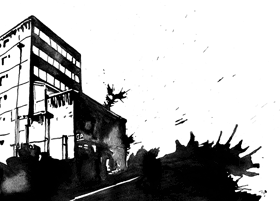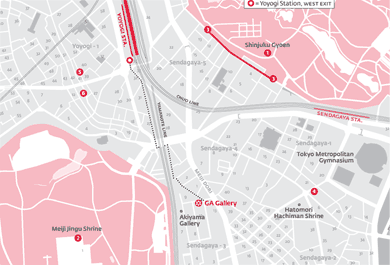GA Gallery
in Yoyogi
access and details
Station: Yoyogi or Kitasando
Lines:Yamanote, Odakyu, Fukutoshin
Access: 10 Minutes walk from Yoyogi Station, 1 minute walk from Kitasando Station
Entry: Adults ¥500
Address: 3-12-14 Sendagaya,
Shibuya-ku, Tokyo
Hours: 12 - 6:30pm;
Closed on national holidays
Tel: 81-(0)3-3404-1461
URL: http://ga-ada.co.jp/english/ga_gallery/
In The Neighborhood
Shinjuku Gyoen {1} and Meiji Jingu Shrine {2} are two obvious points of interest in this area. Just be careful: Shinjuku Gyoen, while beautifully maintained, closes bizarrely early. The narrow road {3} on the outskirts of the park, with its crumbling old homes and small shops, makes for a particularly pleasant walk. Follow it north into the heart of Shinjuku. Off the beaten path, Chako Amemiya {4} serves up ‘American style’ steak. For a drink or some snacks in a laid-back atmosphere, try Bottle Café, {5} or if you’re really into all the subtle variations of sake and sashimi, you’ll find them at Chotto Gobu. {6}
About the Space
Exterior

Background Information
Designed and constructed in 1974 by Makoto Suzuki and its current director Yukio Futagawa, GA Gallery is a well-weathered building dedicated to the display of architecture. Despite Japanese architects having achieved several decades of acclaim both at home and abroad, Tokyo only has two specialist architecture galleries of this kind.
GA Gallery is located between Yoyogi and Harajuku Station in one of those overlooked recesses of the city. The building sits in between the roaring mess of ongoing construction work on Meiji Dori and the busy tracks of Yamanote line, and yet somehow this street manages to retain a sense of calm.
Once you have walked up the cantilevered stairs leading to the gallery, you find yourself in an uncompromising concrete cube of an exhibition space. GA Gallery’s displays aim to illuminate the complexity of the process architects go though in order to design and realize their structures. While you look at schematics and maquettes, the bare concrete walls of the gallery space are a constant, tangible reminder of the physicality of the end result.
Even when the gallery is between exhibitions, it is worth a visit for its bookshop. There you’ll find a comprehensive range of publications, with of course many from the ‘Global Architecture’ range of books and magazines distributed by the architectural publishing house behind the gallery.
